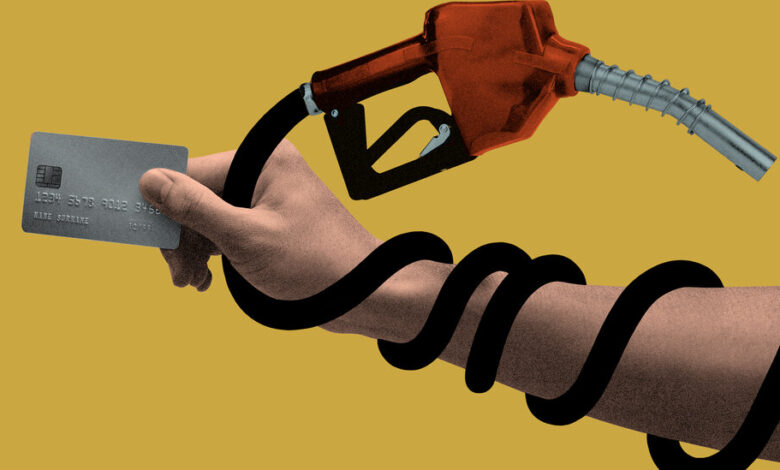Help! A Gas Station Charged Me $1,500 and My Bank Won’t Believe It’s Fraud.

Dear Tripped Up,
Last October, my extended family spent a week in Todos Santos, in Mexico’s Baja California peninsula, for a wedding. All went well, but when I got back, I noticed an unusual charge on my credit card: $1,500.49, made on the day we flew home to the United States from San José del Cabo. The merchant appeared to be a restaurant in Mexico City. I recalled that when we went to fill up the rental car at a Chevron station near the airport, the attendant placed the card in a hand-held machine and then told me it had been rejected, requiring me to use a second card. Nothing else unusual happened that day, and reviews on Google for this gas station contain eerily similar accusations of fraudulent charges from other tourists. I disputed the charge, but Wells Fargo repeatedly denied my claim, even when I asked the Better Business Bureau to intercede. Can you help? Nate, Wayland, Mass.
Dear Nate,
We cannot be sure the fraud occurred at the gas station, but if so, it’s a clever scam. The worker presumably slipped your card into a bogus card reader and charged you $1,500 just as you were rushing to return your rental car and catch a flight out of the country, knowing you were unlikely to report the crime to Mexican authorities. It’s a good reminder for travelers that we need to be ever vigilant on vacation, even when we’re cranky or tired or stressed or otherwise out of our element.
It’s also a good excuse to consider how dependent we have become on our credit card issuers to save the day in such situations. As you found out, that doesn’t always happen.
Humor me while I consider the situation from the perspective of a bank like Wells Fargo. What might seem like obvious fraud when it happens to us is not necessarily a crystal clear crime to a fraud claims team tasked with sifting out their clients who are honest vacationers from others who may themselves be fraudsters.
Since I trust you are in the former camp, I reached out to Wells Fargo and soon afterward, a representative got in touch with you by phone and agreed to refund the charge, plus interest. A week later, you received a check for $1,609.96.
“We take customer concerns seriously and seriously investigate all customer claims,” wrote Jennifer Landan, a spokeswoman for the company, in an email statement to me. “We worked directly with our customer on this matter, and it is resolved.”
But, of course, it should have been resolved earlier and without my intervention. Was there anything you should have done differently? Was there anything Wells Fargo should have done differently?
The answers are yes and yes.
Though you explicitly gave your permission for Wells Fargo to discuss the incident with me, Ms. Langan told me the company would not talk about the particulars of your case. But she did leave a clue, writing to me that Wells Fargo encourages customers to act “when they receive a fraud alert, phone call or correspondence about a transaction.”
So I asked you to look through your phone and email messages with Wells Fargo at the time of your travel, and the bank did send you a fraud alert, via text, at about the time of the transaction. You didn’t get it at the time, you said, because you had not been able to receive messages while in Mexico. And you somehow missed it when you got back home.
Though I encourage everyone to disconnect while traveling, I will henceforth recommend an exception for text messages so you can monitor your credit card transactions. (You might even consider having your bank alert you every time a transaction occurs, even if it is not suspicious, which can also be helpful in monitoring what exchange rate you’re getting.)
What happened on Wells Fargo’s end that led them to reject your claim multiple times? Though I couldn’t get specific details from Ms. Langan, we do know exactly what the Wells Fargo representative said, since you recorded the call with her permission.
The agent told you it was “normal procedure” for Wells Fargo’s fraud teams to deny fraud claims if a chip card was in the owner’s possession the entire time, which you told them it was. But technically speaking, that was incorrect: The card was briefly out of your hands when the station attendant took it and inserted in a hand-held machine at your car window.
OK, so you didn’t see the text alert and didn’t correctly parse exactly what “in your possession” meant. But given your continued appeals and the online reviews of the gas station and others in the area that corroborate your account, it’s disappointing Wells Fargo continued to be so stubborn.
The representative you spoke to conceded the team who worked on your case could have done better. “We are going to try to revise our procedures,” she said, noting that she had coached the person who made the decision on how to do “better, thorough research.”
That’s good to hear, although I’d feel more confident if I had heard it straight from an official company source rather than on a recorded phone call.
Here’s another piece of advice for travelers as mobile card readers become the default form of payment in many places: When possible, ask for the machine and to insert (or tap) the card yourself, watching the screen carefully. In much of the world (though for some reason, not in many American restaurants), the days of a merchant taking your card to the back to run it through a machine (and potentially a skimmer to steal your information) are long gone.
Though you were quite reasonably frustrated with Wells Fargo, let’s be clear here. The real villains are those who committed this crime in the first place and somehow, whether at the gas station or elsewhere, managed to charge $1,500 to a business called Comida Corrida in faraway Mexico City.
I got in touch with Grupo Horizon, which operates the Chevron Emerald gas station you went to, as well as dozens of Chevron stations in the states of Baja California Sur and Sinaloa.
Gilberto Gómez, the company’s business director, responded by email, saying he was unaware of such issues and encouraged you to send him details. “We take follow-ups to this kind of complaint very seriously and meticulously,” he wrote in Spanish. “If there is any harm to our customers attributable to the gas station, we address it.” (I’ve given you his email address and you told me you would follow up with him.)
But considering the Google reviews at this location and several other (non-Chevron) gas stations in the region, I am skeptical that Grupo Horizon is not aware of the problem. Mr. Gómez did not respond when I followed up twice about whether he had seen the Google reviews.
I also got in touch with the Los Cabos Tourism Board. When its managing director, Rodrigo Esponda, got back to me, he said he was “deeply concerned about the situation,” and had spoken to the Baja California Sur state attorney’s office, which told him it was investigating the matter. He also recommended that tourists who have complaints about a business in the region should register them with Mexico’s federal consumer protection organ, Profeco.
In the meantime, could the solution simply be to pay cash at Cabo-area gas stations? Alas, no: There are also reports of gas station attendants switching out large bills customers pay with for smaller ones and demanding more. And don’t even get me started on the Tripped Up complaints that come about the poor customer service travelers encounter in car rental agencies near Mexican beach destinations. The best solution for sun-seekers may be to skip the car rental altogether and hire a driver, use car-share services or take public transportation.
If you need advice about a best-laid travel plan that went awry, send an email to TrippedUp@nytimes.com.
Follow New York Times Travel on Instagram, Twitter and Facebook. And sign up for our weekly Travel Dispatch newsletter to receive expert tips on traveling smarter and inspiration for your next vacation.



